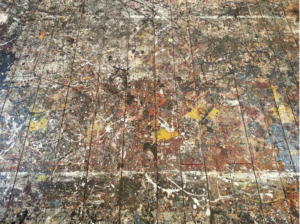Jackson Pollock: A Janusian Genius

This article concerns the life, thoughts, and work of one of the most important abstract expressionism painters in the world. Jackson Pollock was an artist with a volatile personality. This triggered the alcoholism he suffered from throughout his life. Indeed, it seems that all his magnificent work is, in one way or another, linked to his psychological problems.
Although he died prematurely in a car accident, he still managed to enjoy remarkable professional success in his life. Everyone knew him as the crazy genius who splashed paint on canvas. He also invented the artistic technique known as dripping. He combined several elements in this technique. There was the force of gravity, the movement of his body, the paint’s subtle consistency, and the canvas lying on the ground. This technique revolutionized both the art world and the way artists painted.
The artist created this type of painting while he was receiving psychiatric treatment for manic depression. It seems that he started to paint this way while he was recovering. Some professionals identify it as a Janusian process.
Jackson Pollock: his life
Jackson Pollock was born in Wyoming in 1912 to a presbyterian family. He spent his early years in Arizona and California. Indeed, Pollack began studying art in California. However, he had a rebellious nature and was expelled from two different schools when he was very young.
In 1930, he moved with his brother to New York where they both attended the Art Students League. His teacher was Thomas Hart Beaton, who inspired a rhythmic use of painting in Pollock. Pollock went through different creative periods. However, he achieved worldwide fame with his dripping technique.
This extraordinary genius was already struggling with alcohol abuse. It seems he was suffering from some kind of major psychological disorder and was using alcohol to treat its symptoms.
In an attempt to fight his alcoholism, Pollock underwent Jungian psychotherapy with several prestigious doctors. One of them, Dr. Henderson, encouraged him to express himself through his art.
In October 1945, Pollock married Lee Krasner, an American painter he lived with on the south coast of Long Island, New York. Pollock turned the barn of the family home into a studio. There, he perfected his dripping technique.
On August 11, 1956, Jackson Pollock died prematurely in a car accident due to driving while under the influence of alcohol.

Jackson Pollack and bipolar disorder
It was only quite recently that Pollock was diagnosed as having suffered from bipolar disorder. The diagnosis was made in the light of Henderson’s report. The doctor described periods of violent agitation, alternating with paralysis or withdrawal. Another doctor diagnosed Pollock as a manic depressive.
Pollock’s wife helped with the diagnosis of bipolar disorder She provided information on her husband’s changing moods.
“Whatever Jackson felt, he felt more intensely than anyone I’ve known; when he was angry, he was angrier; when he was happy, he was happier; And when he was quiet, he was quieter.”
-Lee Krasner-

Jackson Pollock: Janusian thought
Janusian thought is a concept that suggests you can solve problems when you view things from opposite perspectives. It’s been used a lot, especially in the expression of an artist’s creativity at the highest possible level.
In this sense, creativity, innovation, and disruption go hand in hand with the assimilation and understanding of opposites. They’re then used in ways that have never been used before. It’s a conscious process but a world away from the mental rigidity and irrationality of psychopathological processes.
At the height of his success, Pollock spoke about carrying out his art by hiding and expressing symbols simultaneously. At this time, he started his drip painting, which is an example of a Janusian process. In other words, it’s conceived of multiple opposites.
Jackson Pollock is a good example of an artist whose work combines art with psychology. They merge and maintain a dialogue with the artist himself. The work part of him is born from within, from his unconsciousness. In some way, the work flows and takes on a life of its own.
“When I am in my painting, I’m not aware of what I’m doing. … It is only when I lose contact with the painting that the result is a mess. Otherwise there is pure harmony, an easy give and take, and the painting comes out well.”
-Jackson Pollock-
All cited sources were thoroughly reviewed by our team to ensure their quality, reliability, currency, and validity. The bibliography of this article was considered reliable and of academic or scientific accuracy.
- Emmerling, L. (2003). Pollock. New York: Taschen.
- Naifeh, Steven; Smith, Gregory White (1989). Jackson Pollock: an American saga. Clarkson N. Potter.
This text is provided for informational purposes only and does not replace consultation with a professional. If in doubt, consult your specialist.








